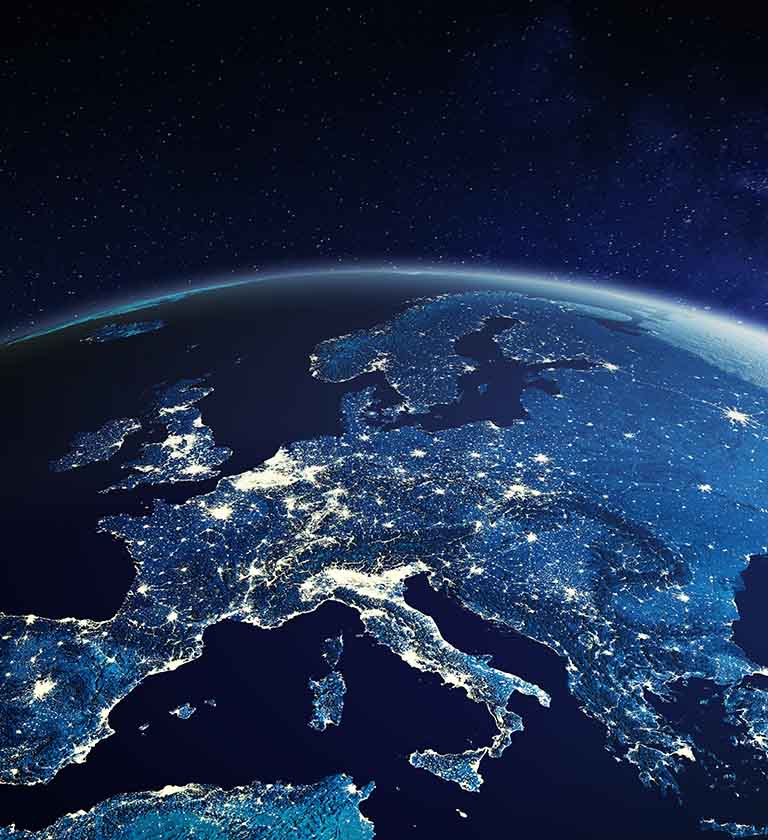-
In the early days, air conditioners were invented to help people stay cool and comfortable indoors even though the weather was in heat. This invention brought comfort into our daily lives but at the same time, the refrigerant used in the air conditioning systems can cause global warming.
Global warming is the phenomenon of a gradual increase in the Earth’s temperature which is normally caused by chlorofluorocarbon (CFC), high levels of carbon dioxide, and other pollutants.


-
Q. How do refrigerants and air conditioners affect global warming?
The light energy emitted by the sun is reflected into Earth's atmosphere when it passes through it and either released into space or absorbed directly into it. As a result, only about 50% of sunlight reaches the Earth’s surface, and the light energy absorbed by the surface changes to thermal energy or infrared light with a long wavelength and is then released back outside. About half of the emitted infrared ray passes through the atmosphere and are reflected into space, but the rest is absorbed by greenhouse effect gases such as clouds, water vapor, and carbon dioxide, which return it to the surface. The repetition of this process has caused global warming which is the phenomenon of a gradual increase in the Earth’s temperature and it has always been an environmental problem that people are concerned about. The same goes for the problems of refrigerants.


-
In the early days, freon gas was widely used in refrigeration and air conditioning systems. Eventually, it contains gases that are harmful to the Earth, causing ozone depletion and contributing to global warming. Therefore, it has been replaced by Chlorofluorocarbon (CFCs) and hydrochlorofluorocarbons (HCFCs) series refrigerants, which have near-zero ozone depletion. However, it was discovered that their ability to absorb infrared rays could potentially add to the issue of global warming.
Since then, many countries have made efforts to impose more stringent refrigerant laws. In April 2022, the European Commission made a legislative proposal to update the original F-gas regulation aiming to phase out HFCs throughout by 2050 and it has started to apply this year in March. Certain goods and equipment that contain F-gases are prohibited from being sold or placed on the market by the regulation. Additionally, it establishes the cutoff dates for when specific goods and equipment cannot be sold. For example, the use of F-gas with a GWP of 150 or higher will be banned in stationary split-air conditioning equipment, and from 2027 to 2035, the use of F-gas for air conditioning systems and heat pumps will also be prohibited based on the product type.1)
-
Q. What is Global Warming Potential (GWP)?
The warming of the Earth can be affected differently by different greenhouse gases. Global Warming Potential (GWP) is an index introduced to measure and compare the impacts of various greenhouse gases on global warming over a specific time. The period usually used for GWPs is 100 years but for gases with shorter lifetimes, an alternative of a period of 20 years is used.
Carbon dioxide is used as a reference gas because it has a long residence of time in the atmosphere and also has the greatest impact on global warming.
In particular, GWP is a measurement of the amount of energy that a ton of gas emissions will absorb in relation to a ton of carbon dioxide emissions over a given period. R-22, for instance, the most common refrigerant today, has a 100-year GWP of 1,810, nearly 2,000 times the potency of carbon dioxide, so one pound of R-22 has almost as much potency as a ton of carbon dioxide.2) Generally, the higher the GWP, the more the gas warms the Earth.
In order to effectively manage, maintain, and comply with regulatory requirements, industry professionals need to possess a thorough understanding of the safety aspects related to refrigerants. As long as the refrigerants are at a safe level, they are allowed to be used. The American Society of Heating, Refrigerating and Air-Conditioning Engineering (ASHRAE) Standard 34, Designation and Safety Classification of Refrigerants has assigned numbers and safety qualifications to the refrigerants based on their toxicity and flammability.
-
Q. What are the safety classifications of refrigerants?
The Refrigerant Safety classification group is made up of a letter (A or B) indicating the toxicity class, followed by a number (1,2, 2L or 3) indicating the flammability class.


-
Class A indicates refrigerants of lower toxicity while Class B indicates refrigerants of higher toxicity. Flammability is divided into three classes with an additional subclassification. Class 1 is refrigerants that do not propagate a flame when tested as per the standard; Class 2 is refrigerants with lower flammability and Class 3 is refrigerants with high flammability such as hydrocarbons. For subclass 2L, it indicates the refrigerants that burn very slowly with a maximum burning velocity of 10cm/s. For example, some of the hydrofluoroolefins (HFOs) can be classified in Class A2L because they are mildly flammable as they have lower toxicity and also burning velocity. Therefore, they have very low global warming potential.3)
The table below shows the safety group and the refrigerants belonging to it.


-
Q. What has changed in regards to the GWP Regulations based on different types of refrigerants?
F-gases are used in many of the products in our daily life. For example, refrigerating and air-conditioning equipment, heat pumps, and also in industrial processes. F-gases are useful but also mainly contribute to the phenomenon known as the greenhouse effect which warms the Earth and also changes in the climate. Furthermore, they have a higher warming potential than carbon dioxide and can remain in the atmosphere for thousands of years.
Now that people are becoming more aware of the environment it has caused the tightening of the refrigerant’s regulations. Especially in European countries, most refrigerants are prohibited except for R290 which can only be used. F-Gas Regulation aims to cut down the usage of F-Gases and also introduce less harmful alternatives. On February 7, 2024, the new F-gas Regulation was adopted and it went into effect on March 11 of that same year.4)
The revised European Refrigerants Regulations are shown in the table below.


-
Conclusion
While air conditioning systems have undoubtedly revolutionized our comfort indoors, their refrigerants pose a significant threat to the environment, contributing to global warming and climate change. The Global Warming Potential (GWP) of these refrigerants, such as R-22, highlights their potency in trapping heat in the atmosphere, far exceeding that of carbon dioxide. To mitigate these effects, regulations have been implemented, focusing on safety classifications and tightening restrictions on the use of harmful refrigerants, particularly in European countries.
LG Component Division also participated in designing and expanding various compressors that use low GWP refrigerants that meet the latest regulations and standards. Now, it is expanding its line-up of compressors for R290 with GWP 3 and R290 has a low GWP value of less than 20, which minimizes the impact on global warming. Let’s anticipate that these LG compressors will help mitigate climate change.
1) ANNEXES to the Proposal for a Regulation of the European Parliament and of the Council on fluorinated greenhouse gases, amending Directive (EU) 2019/1937 and repealing Regulation (EU) No 517/2014, (ANNEX IV, p. 10)
2) California Air Resources Board, High-GWP Refrigerants, https://ww2.arb.ca.gov/resources/documents/high-gwp-refrigerants
3) UNEP/ASHRAE Refrigerant Fact Sheet #1—Update on New Refrigerants Designations and Safety Classifications.
4) European Commision, EU-Rules, https://climate.ec.europa.eu/eu-action/fluorinated-greenhouse-gases/eu-rules_en
-
"The information contained in the article is released by LG Electronics and may not be used for personal work. It may not be copied, reproduced, modified, decompiled, or reverse-engineered into any other work without prior permission from LG Electronics."
-
*Products and solutions may vary according to country and operating conditions.
Please click the 'INQUIRY TO BUY' banner below to contact LG Sales Team for further information on solutions and products.







